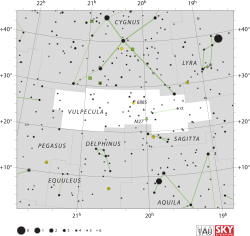|
| 13 Vulpeculae |  | Observationsdata
Epok: J2000.0 |
|---|
| Stjärnbild | Räven |
|---|
| Rektascension | 19t 53m 27,69557s[1] |
|---|
| Deklination | +24° 04′ 46,6099″[2] |
|---|
Skenbar magnitud ( ) ) | +4,57 (V)[3], +4,58 (0,1) (V)[4] |
|---|
| Stjärntyp |
|---|
| Spektraltyp | B9.5 III[3] |
|---|
| U–B | -0,13[5] |
|---|
| B–V | -0,047 ± 0,012[6] |
|---|
| Variabeltyp | Gamma Cassiopeiae-variabel (GCAS:)[4] |
|---|
| Astrometri |
|---|
Radialhastighet ( ) ) | -28,10 ± 1,6[7] km/s |
|---|
| Egenrörelse (µ) | RA: +23,06 ± 0,54[1] mas/år
Dek.: 36,28 ± 0,41[1] mas/år |
|---|
Parallax ( ) ) | 9,75 ± 0,54[1] |
|---|
| Avstånd | 330 ± 20 lå (103 ± 6 pc) |
|---|
Absolut magnitud ( ) ) | -0,48[3] |
|---|
| Detaljer |
|---|
| Radie | 1,3[8] R☉ |
|---|
| Luminositet | 180[3] L☉ |
|---|
| Temperatur | 8 801[9] K |
|---|
| Metallicitet | -0,11 (Fe/H)[3] dex |
|---|
| Vinkelhastighet | 45,0[10] km/s |
|---|
| Andra beteckningar |
|---|
| CCDM J19535+2405AB, GCRV 12239, IRAS 19513+2356, SKY# 37255, GEN# +1.00188260J, JP11 3151, TD1 25642, DJU 4, GSC 02140-03051, 2MASS J19532768+2404464, UBV 16950, AG+23 1981, HD 188260, PLX 4696, uvby98 100188260, AKARI-IRC-V1 J1953276+240446, HIC 97886, PLX 4696.00, WDS J19535+2405AB, ALS 16457, HIP 97886, PPM 109955, WEB 17223, BD+23 3820, HR 7592, ROT 2873, YZ 23 7341, GC 27544, IDS 19492+2349 AB, SAO 87883[2][11] |
13 Vulpeculae, som är stjärnans Flamsteed-beteckning, är en dubbelstjärna[12] belägen i den mellersta delen av stjärnbilden, Räven. Den har en kombinerad skenbar magnitud på ca 4,57[3] och är svagt synlig för blotta ögat där ljusföroreningar ej förekommer. Baserat på parallaxmätning inom Hipparcosuppdraget på ca 9,8[1] mas, beräknas den befinna sig på ett avstånd på ca 330 ljusår (ca 103 parsek) från solen. Den rör sig närmare solen med en heliocentrisk radialhastighet av ca -28 km/s.[7]
Egenskaper
Primärstjärnan 13 Vulpeculae A är en blå till vit jättestjärna av spektralklass B9.5 V.[3] Den har en radie som är ca 1,3[8] solradier och utsänder ca 180[3] gånger mera energi än solen från dess fotosfär vid en effektiv temperatur på ca 8 800 K.[9]
13 Vulpeculae är en misstänkt eruptiv variabel av Gamma Cassiopeiae-typ (GCAS:),[4] som har visuell magnitud +4,58 med en amplitud av 0,1 magnituder utan någon fastställd periodicitet.[4]
Följeslagaren, betecknad 13 Vulpeculae B, är en stjärna av magnitud 7,37, med en omloppsperiod av ungefär 615 år, en excentricitet av ca 0,079[12] och en vinkelseparation av 1,55 bågsekunder.[13]
Se även
Referenser
- Den här artikeln är helt eller delvis baserad på material från engelskspråkiga Wikipedia, 13 Vulpeculae, 6 september 2020.
Noter
- ^ [a b c d e] Van Leeuwen, F. (2007). "Validation of the new Hipparcos reduction". Astronomy and Astrophysics. 474 (2): 653. arXiv:0708.1752. Bibcode:2007A&A...474..653V. doi:10.1051/0004-6361:20078357. Vizier catalog entry
- ^ [a b] ”Basic data: V* 13 Vul – Double or multiple Star” (på engelska). Centre de Données astronomiques de Strasbourg. http://simbad.u-strasbg.fr/simbad/sim-basic?Ident=13+Vul&submit=SIMBAD+search. Läst 5 juli 2019.
- ^ [a b c d e f g h] Anderson, E.; Francis, Ch. (2012). "XHIP: An extended hipparcos compilation". Astronomy Letters. 38 (5): 331. arXiv:1108.4971. Bibcode:2012AstL...38..331A. doi:10.1134/S1063773712050015. Vizier catalog entry
- ^ [a b c d] ”NSV 24927” (på engelska). The International Variable Star Index. AAVSO – American Association of Variable Star Observers. http://www.aavso.org/vsx/index.php?view=detail.top&oid=63362. Läst 5 juli 2019.
- ^ Mallama, A. (2014). "Sloan Magnitudes for the Brightest Stars". The Journal of the American Association of Variable Star Observers. 42: 443. Bibcode:2014JAVSO..42..443M.Vizier catalog entry
- ^ van Leeuwen (2007). ”Hipparcos, the New Reduction” (på engelska). http://vizier.u-strasbg.fr/viz-bin/VizieR-5?-out.add=.&-source=I/311/hip2&HIP=97886. Läst 5 juli 2019.
- ^ [a b] Gontcharov, G. A. (2006). "Pulkovo Compilation of Radial Velocities for 35 495 Hipparcos stars in a common system". Astronomy Letters. 32 (11): 759. arXiv:1606.08053. Bibcode:2006AstL...32..759G. doi:10.1134/S1063773706110065.
- ^ [a b] Pasinetti Fracassini, L. E.; et al. (February 2001). "Catalogue of Apparent Diameters and Absolute Radii of Stars (CADARS)". Astronomy and Astrophysics (Third ed.). 367 (2): 521–524. arXiv:astro-ph/0012289. Bibcode:2001A&A...367..521P. doi:10.1051/0004-6361:20000451.
- ^ [a b] McDonald, I.; Zijlstra, A. A.; Boyer, M. L. (2012). "Fundamental parameters and infrared excesses of Hipparcos stars". Monthly Notices of the Royal Astronomical Society. 427: 343. arXiv:1208.2037. Bibcode:2012MNRAS.427..343M. doi:10.1111/j.1365-2966.2012.21873.x. Vizier catalog entry
- ^ Glebocki, R.; Gnacinski, P. (2005). "VizieR Online Data Catalog: Catalog of Stellar Rotational Velocities (Glebocki+ 2005)". VizieR On-line Data Catalog: III/244. Originally Published in: 2005csss...13..571G; 2005yCat.3244....0G. 3244. Bibcode:2005yCat.3244....0G. Vizier catalog entry
- ^ "13 Vul". SIMBAD. Centre de données astronomiques de Strasbourg. Hämtad 2019-03-15.
- ^ [a b] Hartkopf, W. I.; et al. (June 30, 2006), Sixth Catalog of Orbits of Visual Binary Stars, United States Naval Observatory, hämtad 2017-06-02.
- ^ Malkov, O. Yu.; Tamazian, V. S.; Docobo, J. A.; Chulkov, D. A. (2012). "Dynamical masses of a selected sample of orbital binaries". Astronomy & Astrophysics. 546: A69. Bibcode:2012A&A...546A..69M. doi:10.1051/0004-6361/201219774. Vizier catalog entry
Externa länkar
|





